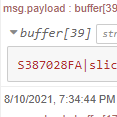SmartSDR v4.1.3 | SmartSDR v4.1.3 Release Notes
SmartSDR v3.10.15 | SmartSDR v3.10.15 Release Notes
The latest 4O3A Genius Product Software and Firmware
Need technical support from FlexRadio? It's as simple as Creating a HelpDesk ticket.
Physical PTT for Remote SmartSDR
Yes I know how to MOX and VOX and the wonderful space bar trick. I still want physical PTT.
Given the following:
* Flex Radio 6xxx
* SmartSDR 2.4.9
* Windows PC with USB and Audio in but NO Serial port
* Open to using other software to assist (like FRStack)
* Open to building interfacee
* Fine with configuring CAT
How would I do this:
Have a physical microphone (Could be be USB or traditional - don't have this yet) and a PTT button
Driving PTT via CAT is my presumption and use something like FRStack to translate to MOX for SmartSDR
I've seen other threads here like putting an Arduino Nano ($30) into a Footswitch and running a Serial to USB Cable ($10-20) but that seems overcomplicated and expensive and was a solve 4 years ago.
Could it now be just as simple as wiring a switch (shorting pins 8 & 9) to a DB9 and then into a Serial To USB Cable and enabling CAT with PTT and running FRStack?
Or is there something a bit more elegant that I'm missing?
Have ya done it? Help me out with your learnings please!
Answers
-
Would this work for you? Not very complicated and very clean.
https://community.flexradio.com/flexradio/topics/remote-footswitch-how-to-lan-vpn-solution
Mike va3mw
1 -
The response from Michael works great for PTT using a FTDI RS-232 cable and is what I have used for the past 11 months.
as far as the Microphone it is also very easy and I have tried many different USB sound card interfaces and have settled on the Shure X2U USB XLR Microphone adapter.
I run this with my Heil PR-40 and audio is superb.
Don't waist your money on the purple Heil USB XLR (not enough audio out) or other USB XLR cable adapter they are very poor audio quality compared to the SHURE X2U adapter and a waist of Money.
Here is a link on Amazon, https://www.amazon.com/Shure-X2U-XLR-to-USB-Signal-Adapter/dp/B001PPXFAG/ref=sr_1_6?ie=UTF8&qid=...
Then you can do as I did and just run your SHURE X2U and Heil PR-40 (or what ever XLR MIC your running) MIC profile using the PC Mic selection, sounds almost as good as running on the Balanced audio connection.
You pay a bit more for this quality device but it is well worth it.
This will give you OUTSTANDING TX Audio on the FLEX6700 or FLEX6600 radio's and I'm sure the other 6xxx radio's running Remote.
Hope this helps.
73's
Bret
WX7Y
1 -
I ended up following along with the tip Michael provided and it served me well.
This push switch is a bit stiff for use so may have to swap it out. I wanted to post this for newbies since much has changed with the advent of the 6xxx series and SmartSDR 2.4.9.
I built a dual RCA based cable so I can swap in different setups if I want and have both Foot and Hand PTT.


Parts I used:
RCA Speaker Y - gauge is a bit too large so you could really just use an old RCA cable and **** out one of them and save some $. This however lets my tie two RCA jacks into same ports on Serial cable and not have to swap out.
https://www.amazon.com/gp/product/B00G352P2C/ref=oh_aui_detailpage_o02_s00?ie=UTF8&psc=1
This is the breakout Serial end that I connected RCA Female (above) to. Notice I chose the male with NUTS that I could ****/bond the cable below too. They have many options so choose carefully!
https://www.amazon.com/gp/product/B07191YHSL/ref=oh_aui_detailpage_o02_s00?ie=UTF8&psc=1
This is the USB to Serial cable I use to go into the computer and Cat/PTT configured for the USB. I chose this one because it had FTDI chip - important. Connected to Windows10 seamlessly and drivers already there.
https://www.amazon.com/gp/product/B075YHFMC7/ref=oh_aui_detailpage_o02_s00?ie=UTF8&psc=1
Finally the switch. It's a bit stiff for such a small button so you might shop around. Use your multi meter to determine which contacts close when it closes BEFORE you solder up.
https://www.amazon.com/gp/product/B00B887GVY/ref=oh_aui_detailpage_o02_s01?ie=UTF8&psc=1
There is just no good way to photograph the end product. **** ugly but functional!
73's and thanks!
Dave N6XVZ
0 -
You can get the parts on ebay for a few dollars or from retailer Quicksiler for a few more dollars. Works up to 300ft away from the radio.
http://www.cs520hams.k5pa.com/downloads/Wireless%20Relay%20WR-SIN%20User%20Manual%20rev-1.pdf
I would recommend you get it from Quicksilver.
John K3MA0 -
Here is a new link to the Sure device
https://www.amazon.com/Shure-X2U-XLR-to-USB-Signal-Adapter/dp/B001PPXFAG/ref=sr_1_1?ie=UTF8&qid=...
0 -
The index finger button on the Flex Control set to MOX is close enough to PTT for me.
0 -
I just tested this under 3.1.12 and it works.
Connect to Radio locally or SmartLink on your Windows computer.
Open SmartCat - make sure it is connected to the same radio
This shows the radio I am connected to and the 'Station' aka, client. In this case, it is my Maestro named VA3MW
Plug in a USB / RS232 cable - Make sure Windows sees it ok. Not the Com #. In my case, it was Com 14
Create a new PTT port with SmartSDR CAT.
The serial port is "Existing" and I picked Com 14 since it is the physical port you installed previously.
It will be attached to Slice A - If you had a Slice B you were going to ask, you would have to duplicate it on another switch, or just use FRstack -- FRStack requires a pullup resistor it seems (I can't seem to find the schematic to do this).
For RTS Active Low, I have the FootSwitch connected across pins 7 and 8 on DB9 Female connector plugged into the USB / RS232 cable. (It was the same cable I used for testing SmartSDR for MAC remote PTT).
I have confirmed that it does work on Local and SmartLink connections.
Mike va3mw
0 -
The solution above is great if you have a DB com port. I use an Aurdino Nano Every in a foot switch to send CAT commands for Mox on\off. This allows me to the usb com ports on a laptop. I can post the Arduino sketch if any one is interested..
0 -
The design I mentioned is for someone who just wants to add a USB/232 cable to their windows PC.
But, the Nano design is pretty cool too to send TX0 and TX1 commands.
Please post the sketch, it would be fun to see.
Mike
0 -
See sketch below. I have found out that my using hardware flow control works best for me. I have been running this on our club 6400 and on the guys can't even tell I am remote. I can't imagine not operating with out it now.
#define PTT 2 // PTT pinD2 var
volatile int PTT_State = HIGH; // volatile, value changes in
ISR
const int bounce_delay = 20;
volatile int bounce_time = 20; // volatile, value changes in
ISR
int PTT_Old_State = HIGH;
void setup() {
pinMode(PTT, INPUT_PULLUP);
attachInterrupt(digitalPinToInterrupt(PTT), switchISR, CHANGE); // attach interrupt handler
Serial.begin(9600); // set baud rate for usb port
delay(100);
}
void loop(){ // put your main code here, to run repeatedly:
if(PTT_State != PTT_Old_State) {
if(PTT_State == LOW) {
pttOn();
} if(PTT_State == HIGH) {
pttOff();
}
PTT_Old_State = PTT_State;
}
}
// Interrupt Service Routine (ISR)
void switchISR () {
if((bounce_time + bounce_delay) >= 50) {
return;
}
PTT_State = digitalRead(PTT);
} // end of switchPressed
//ptt On CAT Command
void pttOn(){
Serial.print("ZZTX1;");
delay(10);
PTT_State = digitalRead(PTT);
}
// ptt Off CAT Command
void pttOff(){
Serial.print("ZZTX0;");
delay(10);
PTT_State = digitalRead(PTT);
}
0 -
The previous sketch did not post well. I am reposting for better clarity.
#define PTT 2 // PTT pinD2 var
volatile int PTT_State = HIGH; // volatile, value changes in ISR
const int bounce_delay = 20;
volatile int bounce_time = 20; // volatile, value changes in ISR
int PTT_Old_State = HIGH;
void setup() {
pinMode(PTT, INPUT_PULLUP);
attachInterrupt(digitalPinToInterrupt(PTT), switchISR, CHANGE); // attach interrupt handler
Serial.begin(9600); // set baud rate for usb port
delay(100);
}
void loop(){ // put your main code here, to run repeatedly:
if(PTT_State != PTT_Old_State) {
if(PTT_State == LOW) {
pttOn();
} if(PTT_State == HIGH) {
pttOff();
}
PTT_Old_State = PTT_State;
}
}
// Interrupt Service Routine (ISR)
void switchISR () {
if((bounce_time + bounce_delay) >= 50) {
return;
}
PTT_State = digitalRead(PTT);
} // end of switchPressed
//ptt On CAT Command
void pttOn(){
Serial.print("ZZTX1;");
delay(10);
PTT_State = digitalRead(PTT);
}
// ptt Off CAT Command
void pttOff(){
Serial.print("ZZTX0;");
delay(10);
PTT_State = digitalRead(PTT);
}
If you want to send a dax off command just insert the following code in your sketch:
void daxOff(){
Serial.print("ZZDX0;");
}
Then add daxOff() to the main loop:
void loop(){ // put your main code here, to run repeatedly:
if(PTT_State != PTT_Old_State) {
if(PTT_State == LOW) {
daxOff();
delay(10);
pttOn();
} if(PTT_State == HIGH) {
pttOff();
}
PTT_Old_State = PTT_State;
}
}
0 -
I think a Link to the Ardunio Sketch might be helpful
Versus typing it all in, I am obviously a newbie to Arduino
I am also wondering where is the best resource for all things Arduino for Ham Radio?
Di Dit
Steve
KG5VK0 -
Copy the sketch and paste into your IDE.
0 -
I wonder if you posting it in GitHub might be a better choice since this forum does mess up formatting.
Mike
0 -
0
-
Pin 7&8 short a 104 capacity0
-
Hello Mike
Thank you very much for your good tips regarding a foot switch which is connected to the PC via RS232. I have rebuilt this and have also made the PTT settings under CAT the same as you. Result: When pressing the button, the software goes to send, but my modulation is not sent. When I go on the air with the MOX button, it also sends modulation. Which setting do you think I forgot to make? Surely just a button press somewhere in the SmartSDR, right?
Best 73 de HB9EHO
Matthias0
Leave a Comment
Categories
- All Categories
- 381 Community Topics
- 2.1K New Ideas
- 632 The Flea Market
- 8.3K Software
- 127 SmartSDR+
- 6.4K SmartSDR for Windows
- 185 SmartSDR for Maestro and M models
- 430 SmartSDR for Mac
- 272 SmartSDR for iOS
- 259 SmartSDR CAT
- 195 DAX
- 382 SmartSDR API
- 9.4K Radios and Accessories
- 40 Aurora
- 265 FLEX-8000 Signature Series
- 7.2K FLEX-6000 Signature Series
- 955 Maestro
- 56 FlexControl
- 866 FLEX Series (Legacy) Radios
- 927 Genius Products
- 464 Power Genius XL Amplifier
- 338 Tuner Genius XL
- 125 Antenna Genius
- 297 Shack Infrastructure
- 209 Networking
- 460 Remote Operation (SmartLink)
- 144 Contesting
- 788 Peripherals & Station Integration
- 140 Amateur Radio Interests
- 1K Third-Party Software





